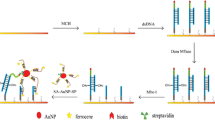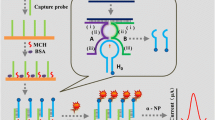Abstract
We describe a highly sensitive and selective molecular beacon-based electrochemical impedance biosensor for the sequence-specific detection of DNA. DNA-capped conjugates between gold nanoparticles (Au-NPs) and streptavidin are used for signal amplification. The molecular beacon was labeled with a thiol at its 5′ end and with biotin at its 3′ end, and then immobilized on the surface of a bare gold electrode through the formation of Au-S bonds. Initially, the molecular beacon is present in the “closed” state, and this shields the biotin from being approached by streptavidin due to steric hindrance. In the presence of the target DNA, the target DNA molecules hybridize with the loop and cause a conformational change that moves the biotin away from the surface of the electrode. The biotin thereby becomes accessible for the reporter (the DNA-streptavidin capped Au-NPs), and this results in a distinct increase in electron transfer resistance. Under optimal conditions, the increase in resistance is linearly related to the logarithm of the concentration of complementary target DNA in the range from 1.0 fM to 0.1 μM, with a detection limit of 0.35 fM (at an S/N of 3). This biosensor exhibits good selectivity, and acceptable stability and reproducibility.

We fabricated a novel sensitive electrochemical DNA biosensor based on the molecular beacon and conjugates composed of report DNA, Au-NPs and streptavidin (DAS) amplification signal protocol. The biosensor exhibits high sensitivity and good specificity even for single-mismatched DNA detection.







Similar content being viewed by others
References
Tyagi S, Kramer FR (1996) Molecular beacons: probes that fluoresce upon hybridization. Nat Biotechnol 14:303–308
Tsourkas A, Behlke MA, Rose SD, Bao G (2003) Hybridization kinetics and thermodynamics of molecular beacons. Nucleic Acids Res 31:1319–1330
Bonnet G, Tyagi S, Libchaber A, Kramer FR (1999) Thermodynamic basis of the enhanced specificity of structured DNA probes. Proc Natl Acad Sci 96:6171–6176
Dubertret B, Calame M, Libchaber AJ (2001) Single-mismatch detection using gold-quenched fluorescent oligonucleotides. Nat Biotechnol 19:365–370
Li F, Huang Y, Yang Q, Zhong ZT, Li D, Wang LH, Song SP, Fan CH (2010) A graphene-enhanced molecular beacon for homogeneous DNA detection. Nanoscale 2:1021–1026
Mao X, Jiang JH, Xu XM, Chu X, Luo Y, Shen GL, Yu RQ (2008) Enzymatic amplification detection of DNA based on “molecular beacon” biosensors. Biosens Bioelectron 23:1555–1561
Xiao Y, Qu XG, Plaxco KW, Heeger AJ (2007) Label-free electrochemical detection of DNA in blood serum via target-induced resolution of an electrode-bound DNA pseudoknot. J Am Chem Soc 129:11896–11897
Lin LQ, Liu QC, Wang LM, Liu AL, Weng SH, Lei Y, Chen W, Lin XH, Chen YZ (2011) Enzyme-amplified electrochemical biosensor for detection of PML-RAR α fusion gene based on hairpin LNA probe. Biosens Bioelectron 28:277–283
Liu ZY, Zhang W, Zhu SY, Zhang L, Hu LZ, Parveen SM, Xu GB (2011) Ultrasensitive signal-on DNA biosensor based on nicking endonuclease assisted electrochemistry signal amplification. Biosens Bioelectron 29:215–218
Fan H, Zhao K, Lin Y, Wang XY, Wu B, Li QG, Cheng L (2011) A new electrochemical biosensor for DNA detection based on molecular recognition and lead sulfide nanoparticles. Anal Biochem 419:168–172
Wang Y, Li CJ, Li XH, Li YF, Kraatz HB (2008) Unlabeled hairpin-DNA probe for the detection of single-nucleotide mismatches by electrochemical impedance spectroscopy. Anal Chem 80:2255–2260
Liu G, Wan Y, Gau V, Zhang J, Wang LH, Song SP, Fan CH (2008) An enzyme-based E-DNA sensor for sequence-specific detection of femtomolar DNA targets. J Am Chem Soc 130:6820–6825
Farjami E, Clima L, Gothelf K, Ferapontova EE (2011) “Off-on” electrochemical hairpin-DNA-based genosensor for cancer diagnostics. Anal Chem 83:1594–1602
Hwang S, Kim E, Kwak J (2005) Electrochemical detection of DNA hybridization using biometallization. Anal Chem 77(2):579–584
Bonanni A, Esplandiu MJ, Valle M (2008) Signal amplification for impedimetric genosensing using gold-streptavidin nanoparticles. Electrochim Acta 53:4022–4029
Meng XM, Xu MR, Zhu JY, Yin HS, Ai SY (2012) Fabrication of DNA electrochemical biosensor based on gold nanoparticle locked nucleic acid modified hairpin DNA and enzymatic signal amplification. Electrochim Acta 71:233–238
Chen X, Hong CY, Lin YH, Chen JH, Chen GN, Yang HH (2012) Enzyme-free and label-free ultrasensitive electrochemical detection of human immunodeficiency virus DNA in biological samples based on long-range self-assembled DNA nanostructures. Anal Chem 84:8277–8283
Dong XY, Mi XN, Wang B, Xu JJ, Chen HY (2011) Signal amplification for DNA detection based on the HRP-functionalized Fe3O4 nanoparticles. Talanta 84:531–537
Patolsky F, Ranjit KT, Lichtenstein A, Willner I (2000) Dendritic amplification of DNA analysis by oligonucleotide-functionalized Au-nanoparticles. Chem Commun 12:1025–1026
Wang J, Liu GD, Jan MR (2004) Ultrasensitive electrical biosensing of proteins and DNA: carbon-nanotube derived amplification of the recognition and transduction events. J Am Chem Soc 126:3010–3011
Li XM, Fu PY, Liu JM, Zhang SS (2010) Biosensor for multiplex detection of two DNA target sequences using enzyme-functionalized Au nanoparticles as signal amplification. Anal Chim Acta 673:133–138
Wang J, Li JH, Baca AJ, Hu JB, Zhou FM, Yan W, Pang DW (2003) Amplified voltammetric detection of DNA hybridization via oxidation of ferrocene caps on gold nanoparticle/streptavidin conjugates. Anal Chem 75:3941–3945
Huang L, Zhang YZ (2012) Label-free electrochemical DNA biosensor based on a glassy carbon electrode modified with gold nanoparticles, polythionine, and graphene. Microchim Acta 176:463–470
Storhoff JJ, Elghanian R, Mucic RC, Mirkin CA, Letsinger RL (1998) One-pot colorimetric differentiation of polynucleotides with single base imperfections using gold nanoparticle probes. J Am Chem Soc 120:1959–1964
Zhang LP, Gong WJ, Pan Y, Zhang YZ (2008) Fabrication of multilayer film modified gold electrode composed of myoglobin, chitosan, and polyelectrolyte wrapped multi-wall carbon nanotubes by layer-by-layer assembled technique and electrochemical catalysis for hydrogen peroxide and trichloroacetic acid. Russ J Electrochem 44(11):1271
Thobhani S, Attree S, Boyd R, Kumarswami N, Noble J, Szymanski M, Porter RA (2010) Bioconjugation and characterisation of gold colloid-labelled proteins. J Immunol Methods 356:60–69
Döllefeld H, Weller H, Eychmüller A (2001) Particle-particle interactions in semiconductor nanocrystal assemblies. Nano Lett 1:267–269
Li HX, Rothberg L (2004) Colorimetric detection of DNA sequences based on electrostatic interactions with unmodified gold nanoparticles. Proc Natl Acad Sci U S A 101:14036–14039
Dong X, Lu XC, Zhang KY, Zhang YZ (2013) Chronocoulometric DNA biosensor based on a glassy carbon electrode modified with gold nanoparticles, poly (dopamine) and carbon nanotubes. Microchim Acta 180:101–108
Zhang J, Song SP, Zhang LY, Wang LH, Wu HP, Pan D, Fan CH (2006) Sequence-specific detection of femtomolar DNA via a chronocoulometric DNA sensor (CDS): effects of nanoparticle-mediated amplification and nanoscale control of DNA assembly at electrodes. J Am Chem Soc 128:8575–8580
Fan CH, Plaxco KW, Heeger AJ (2003) Electrochemical interrogation of conformational changes as a reagentless method for the sequence-specific detection of DNA. Proc Natl Acad Sci U S A 100:9134–9137
Acknowledgments
This work was financially supported by the National Natural Science Foundation of China (No. 20675002).
Author information
Authors and Affiliations
Corresponding author
Rights and permissions
About this article
Cite this article
Fang, X., Jiang, W., Han, X. et al. Molecular beacon based biosensor for the sequence-specific detection of DNA using DNA-capped gold nanoparticles-streptavidin conjugates for signal amplification. Microchim Acta 180, 1271–1277 (2013). https://doi.org/10.1007/s00604-013-1044-1
Received:
Accepted:
Published:
Issue Date:
DOI: https://doi.org/10.1007/s00604-013-1044-1




